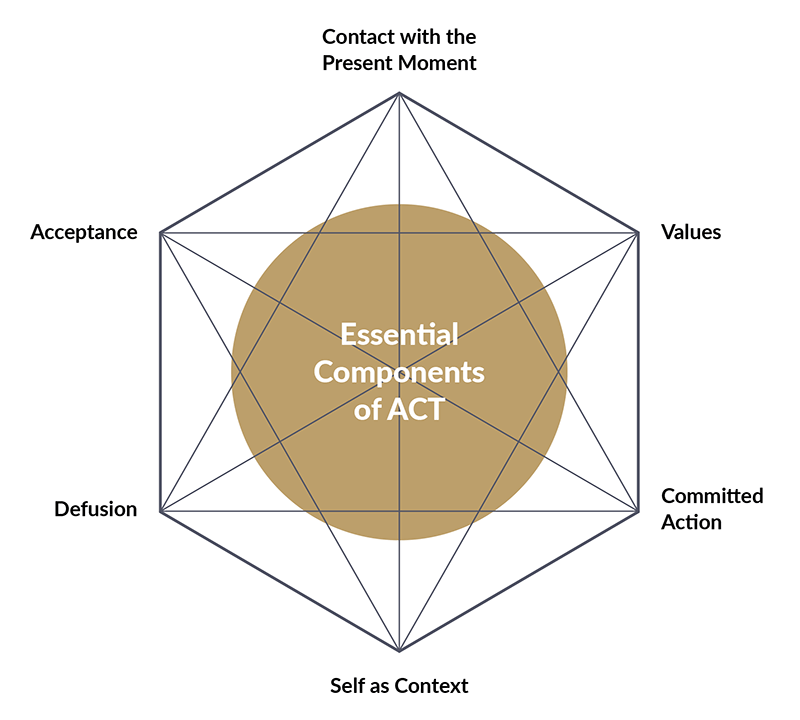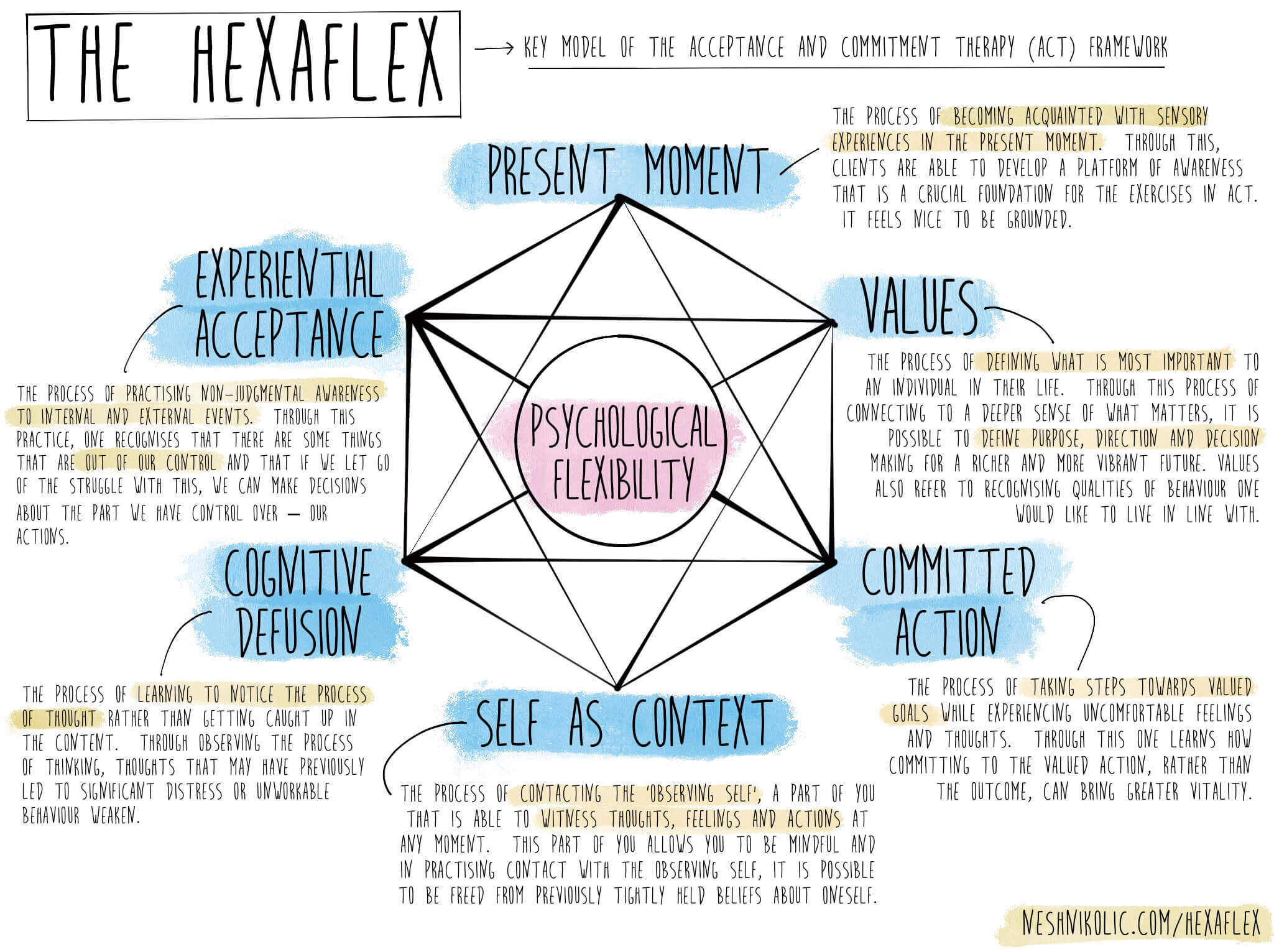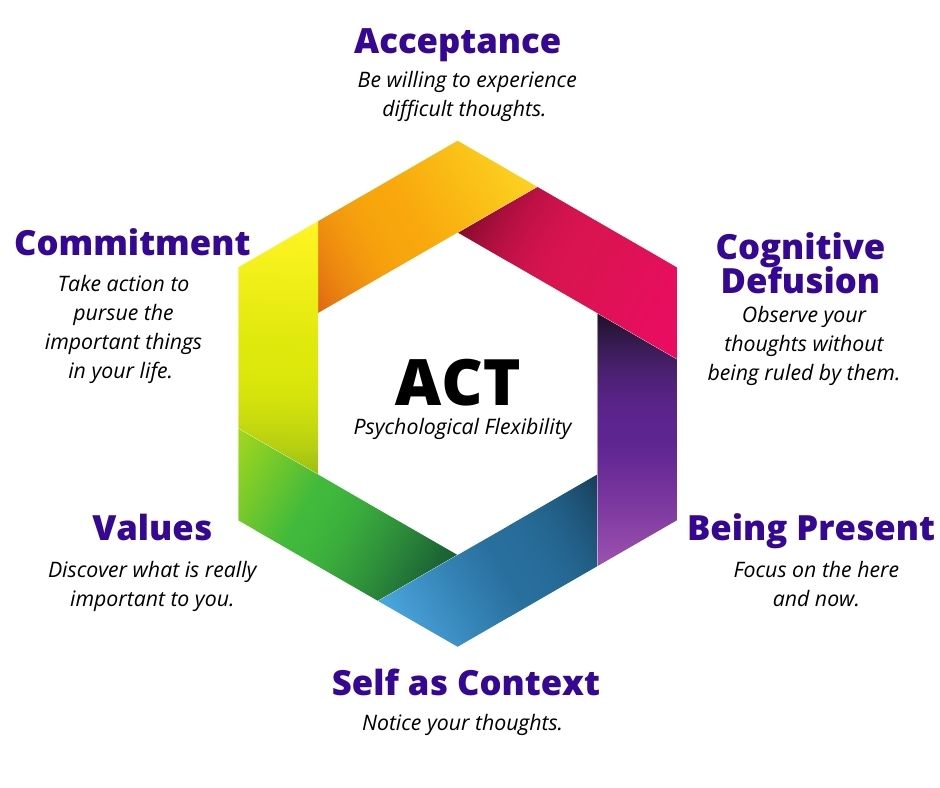
ACT Hexaflex Acceptance and Commitment Therapy Pinterest The o'jays, Wells and Flexibility
This figure is a combination of the Figs. 3.2 and 3.3 in Hayes et al. (2012) from publication: Cognitive behavioral therapy (CBT), acceptance and commitment therapy (ACT), and Morita therapy (MT.
The ACT hexaflex. From "Acceptance and Commitment Therapy Model,... Download Scientific Diagram
4/21/2005. Slide 19. We Can Now Define ACT. ACT is a functional contextual therapy approach based on Relational Frame Theory which views human psychological problems dominantly as problems of psychological inflexibility fostered by cognitive fusion and experiential avoidance. In the context of a therapeutic relationship, ACT brings direct.

Acceptance and Commitment Therapy, illustrated using the Hexaflex model... Download Scientific
Acceptance and commitment therapy is a form of psychotherapy that combines cognitive-behavioral and mindfulness strategies to help individuals improve their mental well-being and achieve their life goals.

Psychological flexibility Acceptance and Commitm... SANE Forums
Acceptance and commitment therapy (ACT) is more than just a set of techniques for structuring psychotherapeutic treatment; it also offers a new and insightful, transdiagnostic approach to case conceptualization and to mental health in general.

(CLOSED) Acceptance and Commitment Therapy
Acceptance and Commitment Therapy (ACT) is a third-wave Cognitive-Behaviorual Therapy (CBT), centred on the idea of acceptance, presence, and values-focused life as an approach to managing mental health problems. ACT assumes the idea that the human brain is an outdated machine which sooner or later will cause psychological distress for everyone.

Central Constructs for the Theory
The hexaflex is the key model of ACT. Each of the six points form the structure of case formulation and skill development. When clients work through these key areas they are likely to develop increased psychological flexibility.

What Is ACT? The Hexaflex Model and Principles Explained
The hexaflex forms the core of acceptance and commitment therapy. In this article, we'll explain what it is, why it's formed, and how useful it is in improving our lives. The acceptance and commitment therapy (ACT) model is characterized by giving relevance to the context of a situation.

Act Etsy
Acceptance and commitment therapy (ACT) is a method of psychotherapy that was gradually developed by Steven Hayes and colleagues [34]. ACT uses mindfulness as one of its main techniques.. The therapeutic model for ACT is known as the ACT hexaflex, which includes cognitive defusion, acceptance, self as context, contact with the present moment.

Acceptance Commitment Therapy ACT Hexaflex Etsy
Published on Jul 17, 2019 Acceptance and Commitment Therapy (ACT) by Bárbara Moura and Rita Almeida Leite Cite Social Download Contents last released 4 years ago Show details Brief Historic Overview Over the last several years a third wave of behavior therapy has emerged from within both the cognitive and behavioral traditions.

Image result for ACT hexaflex tree diagram, kelly wilson Tree diagram, Mind body connection
The Hexaflex in Acceptance and Commitment Therapy (ACT): ACT is a therapeutic approach that focuses on psychological flexibility, which is central to mental well-being. The Hexaflex is a fundamental concept in ACT, representing six interconnected components: Cognitive Defusion: Cognitive defusion involves separating yourself from your thoughts.

PPT Acceptance and Commitment Therapy (ACT) PowerPoint Presentation, free download ID6888052
Key Points Acceptance means actively contacting psychological experiences directly, fully, without needless defense while behaving effectively. The focus of acceptance is on private experiences. If there are public obstacles that you can work with, the ACT approach would encourage committing to changing what you can.

PPT Acceptance and Commitment Therapy PowerPoint Presentation, free download ID1937366
Acceptance and Commitment Therapy (ACT) is a third-wave Cognitive-Behavioral Therapy (CBT) that can be a breath of fresh air for coaches and therapists. Third-wave CBT therapies incorporate mindfulness as their distinguishing factor.

The ACT Hexaflex — Nesh Nikolic
ACT is based on a model of six core processes called the hexaflex. The key objective of ACT is to alleviate suffering by optimizing psychological flexibility. This is achieved through educating clients about the six core processes and supporting the development of new psychological skills, including mindfulness, cognitive defusion, and acceptance.

Acceptance and commitment therapy model. Download Scientific Diagram
This worksheet's beliefs are based on Acceptance and Commitment Therapy (ACT), a therapy method that combines cognitive-behavioral treatments with mindfulness techniques. The ACT Hexaflex, which consists of six fundamental activities, is intended to improve psychological flexibility. Each component targets a distinct aspect of the human.

What is Acceptance and Commitment Therapy? Thrive Training Consulting
It is a unique signifier that separates ACT theoretically and practically from other approaches, especially since these days more and more are integrating mindfulness, acceptance, and behavior analysis principles into their models (largely in part due to the influence of ACT itself).

The “hexaflex” concept in Acceptance and Commitment Therapy (ACT). The... Download Scientific
Acceptance involves the active and aware embrace of those private events occasioned by one's history without unnecessary attempts to change their frequency or form, especially when doing so would cause psychological harm.